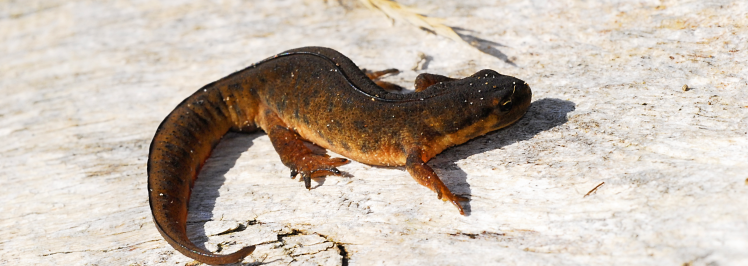
The smooth newt (Lissotriton vulgaris), is the only member of the Urodela (the tailed amphibians) found in Ireland. While commonly encountered near water bodies, adult newts are actually terrestrial, only returning to water bodies to breed. They tend to prefer habitats that offer protection from desiccation, such as long grass, woodland and scrubland. Newts will over-winter in refugia such as woodpiles and rotting logs, which offer them some protection from the elements.
With the advent of the breeding season, newts migrate to water bodies to find a mate. During this time, male newts undergo a remarkable change in appearance. In addition to an increase in size of the spots on their skin, their undersides turn bright orange, their hind feet become more webbed and they develop a pronounced dorsal crest. Females are comparatively more drab in appearance.

During the breeding season, which typically lasts from February to June, males perform a courtship dance to attract potential mates. Successful males will lead their partners over a sperm packet that they will have deposited. The female absorbs this packet through her cloaca, and the eggs are fertilised internally. As the female lays her eggs (As may as 300 of them), she wraps each one in the leaf of an aquatic plant. The larval newts that hatch from these eggs look very similar to the tadpoles of common frogs. The larval newts have large feathery gills which are absorbed back into the body as they undergo metamorphosis. As metamorphosis progresses, the forelimbs will develop before the hindlimbs (the opposite is true of the common frog). The juvenile newts, known as “efts”, emerge from the waterbody looking like miniature adults, and will take 2-3 years to reach maturity.
Smooth newts are occasionally confused with the common lizard (Zootoca vivipara) though, once you know what to look for, the two can be quite easily distinguished. For starters, the newt has smooth skin while the lizard is scaly. Newts have five digits on their hind limbs and four on their forelimbs, while lizards have five digits on both hind- and forelimbs. Behavioural differences can also help differentiate between the two, so an animal found in a water body will almost certainly be a newt, while an animal found basking in a sunny spot is likely to be a lizard.

